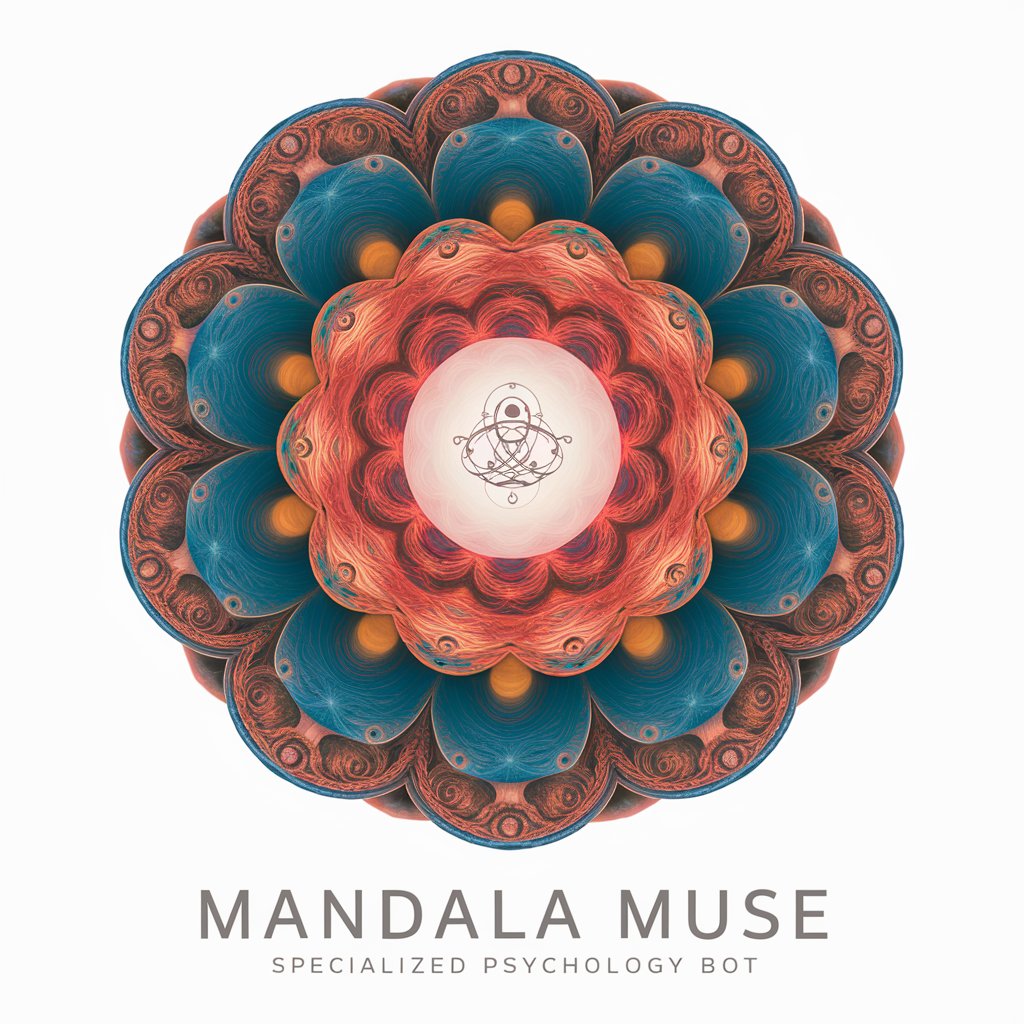Jungian Mandalas - Jungian Mandala Creation

Hello! What's your name? Let's create a transformative mandala together.
Transform Your Psyche with AI-Powered Mandalas
Tell me about a recent dream or significant experience.
What colors and symbols resonate with your current emotional state?
Describe a challenge you're facing that you would like to transform.
What aspects of your inner world would you like to explore through a mandala?
Get Embed Code
Understanding Jungian Mandalas
Jungian Mandalas are based on the concept introduced by Carl Jung, a Swiss psychiatrist, who explored the mandala's ability to reflect the individual's subconscious and serve as a tool for personal growth and self-integration. A Jungian Mandala is an abstract, symmetrical visual representation that encompasses various elements symbolizing different aspects of the psyche, aiming to achieve balance and wholeness within the individual. This concept is rooted in Jung's belief that the mandala pattern is a fundamental form found in nature and human consciousness, representing the totality of the self. Examples of Jungian Mandalas might include circular designs with intricate patterns and symbols that are deeply personal, often created during moments of introspection or therapy. They serve as a meditative focus that aids in the individuation process, a journey towards self-realization and psychological integration. Scenarios where these mandalas are utilized include therapeutic settings, personal development workshops, or individual practices aimed at exploring the unconscious and fostering a deeper understanding of oneself. Powered by ChatGPT-4o。

Functions of Jungian Mandalas
Self-reflection and introspection
Example
A person going through a significant life transition might create a mandala that reflects their current emotional landscape, using symbols and colors that resonate with their inner feelings.
Scenario
In a therapy session, the therapist might encourage the creation of a mandala to help the client visualize and confront their internal conflicts, leading to insights and emotional healing.
Aid in the individuation process
Example
An individual seeking personal growth might regularly create mandalas as a form of meditation, each representing different aspects of their psyche they wish to explore or integrate.
Scenario
A personal development workshop might involve participants creating mandalas to represent their shadows and personas, facilitating discussions around self-acceptance and transformation.
Stress reduction and meditation
Example
Creating a mandala focusing on harmonious patterns and soothing colors can serve as a calming activity, reducing stress and promoting a meditative state.
Scenario
In a high-stress work environment, employees might engage in mandala drawing sessions as a mindfulness exercise to alleviate stress and enhance focus.
Who Benefits from Jungian Mandalas
Individuals seeking personal growth
People who are on a journey of self-discovery and personal development find Jungian Mandalas particularly beneficial. The process of creating mandalas facilitates a deep dive into the unconscious, allowing for a greater understanding of oneself and fostering personal transformation.
Therapy clients
Clients in psychotherapy who are exploring their inner worlds and working through psychological issues can use Jungian Mandalas as a therapeutic tool. They offer a creative and non-verbal means of expressing emotions and conflicts, aiding in the therapeutic process.
Meditation and mindfulness practitioners
Individuals engaged in meditation and mindfulness practices use mandalas as a focus for meditation, helping to center the mind and promote a state of peace and balance. This practice is suitable for anyone seeking stress reduction and mental clarity.

Using Jungian Mandalas: A Step-by-Step Guide
1. Start Your Journey
Begin by visiting a platform that offers a free trial without the need for login or a ChatGPT Plus subscription, enabling easy access to Jungian Mandalas creation.
2. Explore Your Inner World
Reflect on your current emotional state, thoughts, and inner conflicts. This introspection will serve as the foundation for your mandala, guiding its design and symbolism.
3. Create Your Mandala
Use the tool to describe your inner reflections, emotions, and the transformation you seek. The AI will then generate a unique Jungian mandala that visually represents your inner psyche.
4. Reflect and Refine
Examine the mandala and the feelings it evokes. You can refine your description based on these reflections to adjust the mandala until it resonates deeply with your inner journey.
5. Practice Regularly
Incorporate the creation of mandalas into your daily or weekly routine to continually explore and transform your inner world, following Carl Jung's practice for achieving wholeness.
Try other advanced and practical GPTs
SIWAgpt
Empowering insights with AI precision.

AI Ads Assistant
Streamline Your Ad Campaigns with AI

Geriatrics
Empowering Elder Care with AI

Punk Music
Explore the rebellion and culture of punk music.

Country Music
Explore the Roots and Evolution of Country Music

Music Quiz - Picture Round Creator
Engage and Educate with AI-Powered Music Quizzes

Horror
Discover the Depths of Horror

PieGPT
Baking humor into AI responses.

Ghost Writer
AI-Powered Music Composition Made Simple

Bahamas Vacation
Unlock the best of Bahamas with AI

Travel Guide and Itinerary Advisor
Empowering Your Journey with AI

Hawaiian Vacation
Explore Hawaii with AI-powered insights

Frequently Asked Questions About Jungian Mandalas
What is a Jungian Mandala?
A Jungian mandala is an abstract, symbolic representation designed to explore and integrate various aspects of the individual's unconscious and conscious mind. It's a tool for psychological growth and self-discovery, inspired by Carl Jung's theories.
How can Jungian Mandalas aid in personal growth?
By reflecting on and creating mandalas, individuals can uncover hidden aspects of their psyche, resolve internal conflicts, and progress towards psychological wholeness and self-realization. It's a form of active imagination and meditation.
Can I customize my Jungian Mandala?
Yes, the tool allows for customization based on your reflections and emotional state. You can refine your input to alter the mandala, making it a more accurate representation of your inner world.
Is prior knowledge of Jungian psychology required?
No prior knowledge is necessary. The tool is designed to be accessible to everyone, regardless of their familiarity with Jungian psychology, making it a valuable resource for personal exploration.
How often should I create a Jungian Mandala?
The frequency can vary based on personal preference and goals. However, incorporating mandala creation into your regular routine, such as daily or weekly, can significantly enhance your journey towards self-discovery and wholeness.
